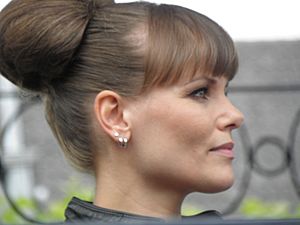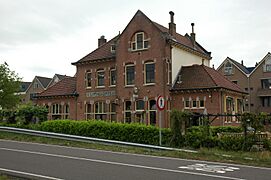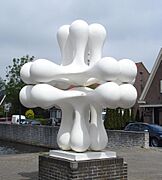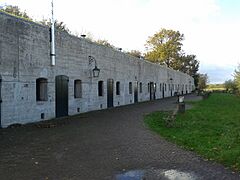Uithoorn facts for kids
Quick facts for kids
Uithoorn
|
|||
|---|---|---|---|
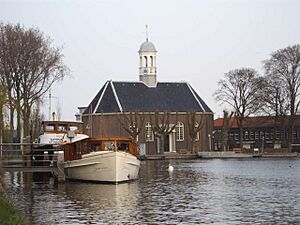
Church in Uithoorn
|
|||
|
|||
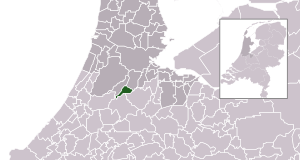
Location in North Holland
|
|||
| Country | Netherlands | ||
| Province | North Holland | ||
| Government | |||
| • Body | Municipal council | ||
| Area | |||
| • Total | 19.42 km2 (7.50 sq mi) | ||
| • Land | 18.24 km2 (7.04 sq mi) | ||
| • Water | 1.18 km2 (0.46 sq mi) | ||
| Elevation | −1 m (−3.3 ft) | ||
| Population
(May 2014)
|
|||
| • Total | 28,482 | ||
| • Density | 1,562/km2 (4,050/sq mi) | ||
| Demonym(s) | Uithoornaar | ||
| Time zone | UTC+1 (CET) | ||
| • Summer (DST) | UTC+2 (CEST) | ||
| Postcode |
1420–1424
|
||
| Area code | 0297 | ||
Uithoorn (pronounced like "out-horn") is a town and a municipality in the Netherlands. It is located in the province of North Holland. This area is known for its beautiful landscapes and rich history.
Contents
Exploring Uithoorn's Communities
The municipality of Uithoorn is made up of two main areas. These are the town of Uithoorn itself and the nearby village of De Kwakel.
A Look at Uithoorn's Past
How Uithoorn Got Its Name
The name De Uithoorn (or De Uythoorn) was first used a long time ago. It appeared at the end of the Middle Ages. The name referred to the place where local courts were held. The village of Uithoorn grew up around this courthouse.
Early Life and Economy
In the beginning, people in Uithoorn mostly worked in farming. They grew crops and raised animals. However, the soil slowly started to sink, making farming harder. Around the year 1600, people began to dig for peat. Peat is a type of soil that can be burned for fuel. Digging for peat created many large ponds. Later, these ponds were drained to create new land for farming, called polders.
Uithoorn During Wartime
In 1672, a difficult year known as the "disaster year" (or rampjaar), the Franco-Dutch War took place. Uithoorn was on the front lines of this war. Because of this, special forts and defenses were built around the town to protect it.
Growth and Industry
During the time of the Batavian Republic, the nearby village of Thamen joined with Uithoorn. For a while, Uithoorn's economy was small. But in the mid-1800s, things started to get better. Some new factories and industries, including chemical plants, were built. More land for farming also became available when large ponds were drained.
In 1863, a factory that made a type of acid was built by the Amstel river. It closed in the early 1900s. Later, in 1922, another company called Teerbedrijf Uithoorn started using the site. This company processed coal tar. It later became known as Cindu Chemicals. Another company, Nevcin Polymers, also operated there. Both companies were very important for providing jobs in Uithoorn.
Around 1885, more forts were built around Uithoorn. These were part of the Stelling van Amsterdam, a defense line to protect the city of Amsterdam.
Trains and Trams
In 1915, a railway line reached Uithoorn. It was part of the former Haarlemmermeer railway lines. The train station was close to the town center. Passenger trains stopped running in 1950, and freight trains stopped in 1972. Most of the railway tracks were removed by 1987. The old Uithoorn railway station building is still there today. Later, a special road for buses was built on part of the old railway path. A new tram line, called the Amsteltram, is planned to open along this path in 2024.
Modern Uithoorn
After World War II, Uithoorn grew very quickly. New neighborhoods were built, like Thamerdal in 1948 and Zijdelwaard in 1960. Later came Legmeer in 1972, and Meerwijk-West and Meerwijk-Oost starting in 1985. In 1991, a new shopping center was built in the heart of the town. This changed the look of the town center quite a bit.
Famous People from Uithoorn
Many interesting people have come from Uithoorn. Here are a few:
- Maarten van 't Kruijs (1813–1885): A Dutch chess player and organist.
- Johannes Voorhout (1647–1717): A famous painter from the Dutch Golden Age.
- Piet Steenkamp (1925–2016): A Dutch politician.
- Hans Koeleman (born 1957): A retired Dutch runner who competed in the Olympics.
- Ruud Koopmans (born 1961): A Dutch expert in sociology and an academic.
- Angela Schijf (born 1979): A well-known Dutch actress.
- Lars Veldwijk (born 1991): A Dutch-born South African professional football player.
Gallery
See also
 In Spanish: Uithoorn para niños
In Spanish: Uithoorn para niños





